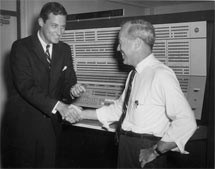
Handy Links
SLAC News Center
SLAC Today
- Subscribe
- Archives: Feb 2006-May 20, 2011
- Archives: May 23, 2011 and later
- Submit Feedback or Story Ideas
- About SLAC Today
SLAC News
Lab News
- Interactions
- Lightsources.org
- ILC NewsLine
- Int'l Science Grid This Week
- Fermilab Today
- Berkeley Lab News
- @brookhaven TODAY
- DOE Pulse
- CERN Courier
- DESY inForm
- US / LHC
SLAC Links
- Emergency
- Safety
- Policy Repository
- Site Entry Form

- Site Maps
- M & O Review
- Computing Status & Calendar
- SLAC Colloquium
- SLACspeak
- SLACspace
- SLAC Logo
- Café Menu
- Flea Market
- Web E-mail
- Marguerite Shuttle
- Discount Commuter Passes
-
Award Reporting Form
- SPIRES
- SciDoc
- Activity Groups
- Library
Stanford
Around the Bay
Thirty-six Years Ago This Month: The November Revolution
This photo, pulled from the SLAC archives, invites a trip back in time to the "November Revolution" of 1974 and beyond. The image is in black and white. The SLAC computing director is wearing a tie and a pocket protector. But what really dates the scene is the massive computer in the background. You can just make out its name, inscribed on a black panel above the machine: IBM System 360. In the 1970s, the 360 series would play a vital role in the Nobel Prize-winning science happening at SLAC.
When the System 360 was released in 1964, IBM Board Chairman Thomas Watson Jr. called the product announcement the most important in the company’s history. The computer was the first to be designed with a standard instruction set for use in both scientific and business applications.
In 1967, SLAC purchased its own IBM 360/75 (the 75 was the model number), upgrading to a model 91 machine in 1968. The computer was retired in 1981, and its console, which measures nearly six feet across, is now housed at the Computer History Museum in Mountain View.
The IBM-360/91 was an enormous machine. Its display boasted so many lights that, according to SLAC Systems Programmer Bob Cook, there was almost always at least one that had burned out. Before an operator could use the display console to diagnose a problem, he would first have to press a button to illuminate all of the lights, and then replace the burnt-out bulbs from a handy box of spares.
Replaceable magnetic-core memory units for the 360/91 were heavy enough that they had to be transported on rollers. This happened more often than a modern-day computer user might expect, as the memory was one of the least reliable parts of the machine. The 360/91 was able to process several instructions in parallel, but this led to another of its quirks: the imprecise interrupt. In the event that the computer detected an error, it could indicate only the approximate location of the failing instruction to the programmer.
Despite the challenges of using the 360, the computer was state-of-the art in its day and provided a large part of the computing power necessary to analyze scientific data at SLAC in the early 1970s. One experiment that relied on the 360’s number crunching capacity went by the cryptic title SLAC-SP-017. Conducted in SPEAR, the experiment examined the particle fallout that occurred when an electron and a positron smashed together, annihilating each other in the process. By adjusting the beam energy, researchers measured the energy dependence of the rate of annihilation events.
On November 10, 1974, measurements in a particular energy range showed an enormous, unexpected surge in the annihilation rate. A new particle, the psi, had been found. The following few weeks were a blur of activity, as the search for additional particles began. On November 20, at 3:20 a.m., a second state, called psi prime was discovered. This heady time of discovery at SLAC was later dubbed the "November Revolution." This work, together with separate experiments at Brookhaven National Laboratory, led to award of the 1976 Nobel Prize in Physics to Burton Richter from SLAC and Samuel Ting of Brookhaven lab, for their "pioneering work in the discovery of a heavy elementary particle of a new kind."
"For most of us, those two weeks were the experience of a lifetime, including the lack of sleep," said SLAC Professor Marty Breidenbach, who was a postdoc at the time of the discovery. Breidenbach and Terry Goldman, now at Los Alamos National Laboratory, had produced a theoretical model that predicted the energy at which the second psi state would occur, and had helped arrange the use of the 360 computer to give nearly instantaneous feedback to researchers in search of the new state.
And it turns out that the big computer was instrumental in more than just analyzing data. When a scheduled maintenance shut-down had to be delayed due to the psi furor, researchers were surprised to see a message sent out to every teletype machine connected to the SLAC computer: "DUE TO NEW PARTICLE DISCOVERY . . . SYSTEM WAS NOT TAKEN DOWN THIS MORNING." The 360/91 was the first to announce the breakthrough.
—Catherine Meyers
SLAC Today, November 4, 2010
